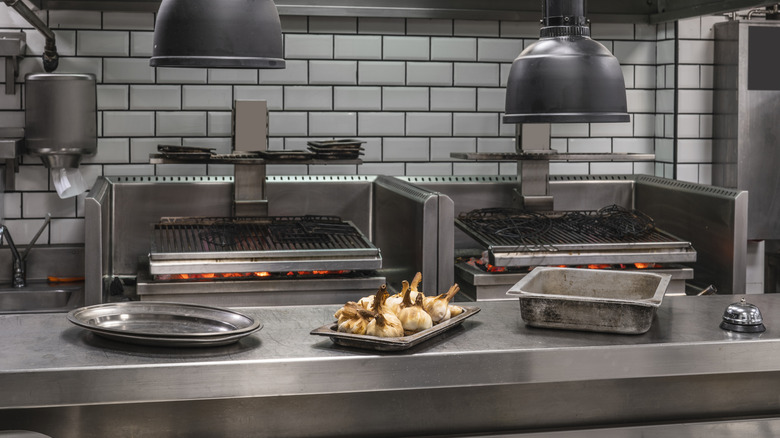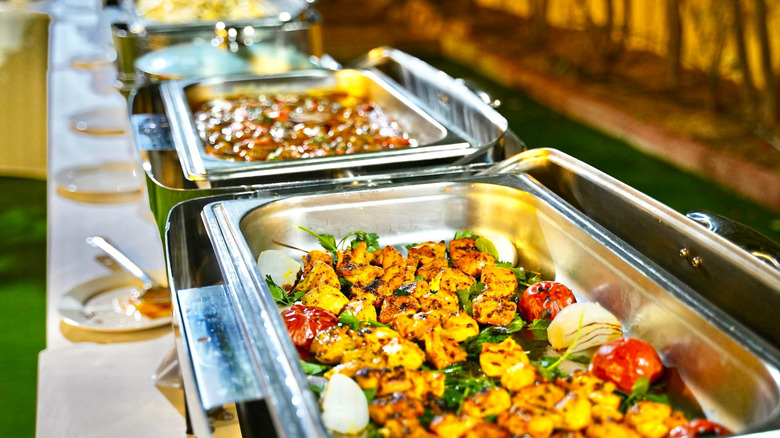The Restaurant Red Flag You Should Never Ever Ignore
We've covered restaurant red flags before. Don't dine at a fast food joint with unexplained odors or view lengthy menus with suspicion. The list goes on and on. Still, it's worth learning the signs because food poisoning is miserable at best and deadly at worst. This time, we're back with another hot tip: If your food is served at the wrong temperature, consider sending it back — or ask for something else.
In food prep, temperature is everything. Piping hot burgers and fries are a good sign that your fast food meal is fresh, and inconsistent temperatures make grocery store hot bars bacteria hotbeds. Bacteria grow quickly when food is held at the wrong temperature, and it's one of the most common food handling mistakes that restaurants make. The food safety industry even gives it a scary-sounding name: time-temperature abuse.
Those food safety geeks aren't being melodramatic — improper food handling is scary. Time-temperature abuse happens when food is held in the danger zone (another scary food safety term, when temperatures are between 40 and 140 degrees Fahrenheit. At these temps, bacteria can double in just 20 minutes.
FDA regulations let restaurants hold food in the danger zone for four hours. However, most food starts to get risky after two hours (or one hour in temperatures over 90 degrees). Even food that meets FDA requirements can be iffy, and not every restaurant plays by the book.
How can you tell if a restaurant is serving food at the wrong temperature?
There's no trick to it; just trust your senses. You probably have a pretty good sense of how food should be served. Steaks should be hot; oysters should be cold. Generally, foods served straight from the fridge — like salads, fresh fruit, and most dairy — should actually feel like food straight from the fridge. Likewise, foods served right out of the oven should feel like that's where it just came from.
Admittedly, unfamiliar foods can throw you off. The first time I had kimbap, I made the rookie mistake of assuming it was just Korean sushi. Nope, kimbap is supposed to be served hot — no food-handling disaster there. Cold soups are traditional in many warmer climates, so don't turn your nose up at a bowl of gazpacho. A surreptitious Google search can clue you in if you don't want to ask your server.
Food handling warning signs to avoid
Some foods pose a bigger risk than others. Be especially wary of meat products, dairy, leafy greens, and cut fruit, like melons. Watch out for neutral or slightly acidic foods, foods with plenty of moisture, and dishes that are high in carbs or protein.
The type of restaurant you're dining at matters, too. It's harder to keep food at a consistent temperature when it's out in the open, so buffets are always suspect. It's easy for customers to accidentally contaminate buffets, too — a double whammy for bacteria growth. Don't assume that fine dining gets a pass, though: An FDA report found that full-service restaurants are more prone to time-temperature abuse than fast food joints.
Politely speak up if your food is raising red flags. Don't feel bad; food served at the wrong temperature is a perfectly valid reason to complain. You may not be able to get a refund without proof of poor handling practices, but you can ask to swap your food out for another, safer dish. Once you leave, consider contacting the local health department so an inspector can give the restaurant a once-over. And lastly, don't go back.


